“Sorry, we went with someone else. Your copy’s good, but it’s not written on-brand.” I was without words.
Disgusted…
…Spit out tomato basil soup poured onto the greying office floor linoleum.
Content and copywriting opportunities always talk about on-brand writing. But on-brand writing is a fuzzy concept. I thought it meant word choice. Turns out I was only 1/3 right.
Now, thanks to Copyhacker’s Master of Brand Voice course, you’ll never again be in the gloomy shadows about what writing on-brand means. Or so they say. Here are 5 huge, copywriter/marketer life changing on-brand writing secrets revealed.

Secrets Uncovered
1.Brand as reflected in voice is definable.
Course host, Justin Blackman, takes you into the story of why he teaches brand voice. Because brands can’t quantify it. And he tells of a personal experience with one such brand who chewed him out. And yet, they couldn’t explain what they wanted. That brand only knew their voice when they heard it.
And that leaves a copywriter at a loss. If you can’t define it, you can only hear it when it’s there or absent, then, how do you match it?
“It doesn’t sound like us.” But what does that even mean?
Blackman pulls the charlatan to the operating table. With his scalpel and tweezers out, he teases a definition for the characteristics of on-brand writing.
Brand voice is formed by the integration of….
- Structure
- Voice
But….
Voice is measurable in 3 parts:
- Vocab
- Tone
- Cadence
Finally, someone cuts through the haze of ‘this isn’t edgy enough for us.’
Vocabulary or Word Choice
Vocabulary of an edgy voice, for instance, uses curse words in casual situations, but to make a point.
“Slow your happy ass down.” For example, tells the reader in an email…. “hey, hit pause. Pay attention. I’m about to tell you something noteworthy….listen up.”
This works well if your ideal client/customer resonates with the phrase.
Tone
How is it said? In other words, what Pastor Sam says in his Sunday sermon vs. what Joe says at the Rangers game with a beer in hand.
They’re on the same topic of taxes. But one out foxes your logic and the other grumbles with clear examples.
Cadence
How fast or slow paced is the delivery of the words in your message? Two words. Sentence variety.
This is the Grammarly piece of writing on-brand. It gets into sentence structure.
Example? Just do it, Nike’s slogan, would be a simple sentence.
Where as….when EF Hutton speaks, people listen? That’s a structurally different sentence. It feels like there’s a kind of introduction before the zinger of the tagline.
Now let’s look at the Master of Brand course’s guarantees.
Master of Brand Voice Course Claims
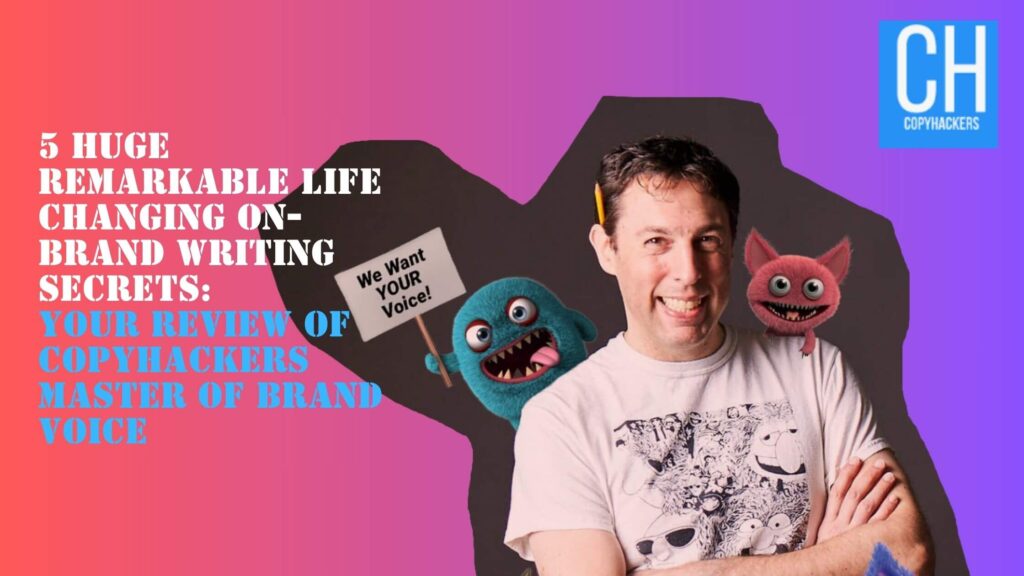
- You can nail any brand voice possible by taking this course.
- You have a 7-day money back guarantee.
By knowing how to define on-brand voice writing, can you nail any voice out there? Nope.
That’s where Blackman turns on the charm. He claims, I’m going to give you a chart where you can plot brand voice on a graph.
Back to the Secrets
2. Brand voice is a measurable asset.
This is the point in the course where brand voice is contextualized with brand personality.
Is the brand you’re writing for speaking….
- ….As an authority in its space?
- ….As a voice that feels approachable and accessible?
- …As a voice that presents a certain life outlook?
If you can….
Answer these 3 questions + 3 voice characteristics = enough info to chart and measure your brand’s voice.
So, let’s look at each in depth.
The question of authority…
Where does your brand fall on this spectrum below?
Sharing mistakes along the way———————————————————-Absolute expert
Brand Accessibility
How accessible is your brand?
The next-door neighbor—————————————————–Lawyer you have to pay for advice
Life Outlook
Is your brand the rule breaker, rule follower, or creator of industry standards?
- Is it pessimistic or optimistic?
- Idealistic?
- Pragmatic?
- Fun-loving?
- Dead serious?
Capturing all these qualities of voice on one map is impressive. Amazing work. Kudos to Blackman.
When you see it, you won’t believe what you’re seeing.
- Awed? Great.
- Disappointed? Hold on for his explanation. Brilliance.
3. There are modern day tools to help you with judging from a small sample of writing what on-brand messaging should look and sound like.
One of these tools mentioned is Prowriting aid. FYI Not a fan. A brain hemorrhage in disguise. So, Blackman’s got differing views from me there. He dives into the stylistic use. Bah! Trash for me.
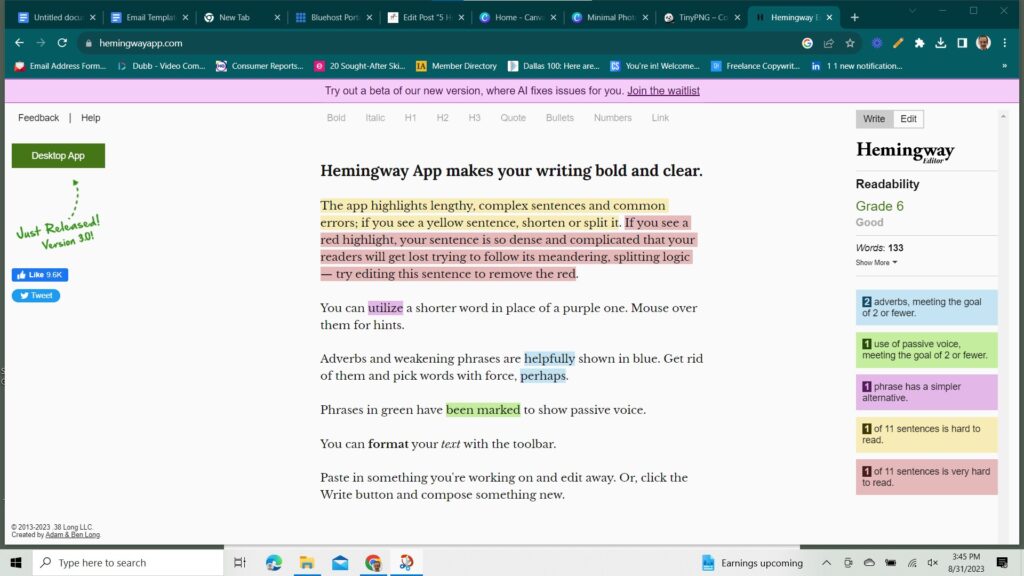
Another tool Blackman recommends is Hemingway. I’ll elaborate. Hemingway is the tool that hates adverbs and helps you see sentence length.
The last tool, IBM Watson Tone Analyzer is no longer free.
Blackman introduces this as one of the best on the market for getting tone down on that graph. But the last software update of IBM Watson, did not improve the program. In fact, it was such a miss, Blackman created his own tool to replace it.
(Yet, access to that tool is available and explanation via taking his course.)
4. I believe Blackman can show you step-by-step how to master any brand’s voice.
And that goes far beyond this Master of Brand Voice course. Blackman has his own school, Pretty Fly Copywriting, to help copywriters get this message match down to a precise skill.
In the course Master of Brand Voice, Blackman gives you not only
- 1 hour 18 minutes
- 15 bite-sized lessons
- His definition of brand voice
- Chart to measure voice on
- Access to electronic tools
- Over the shoulder tutorials to give you brand voice analysis examples
But…
He also provides you with links to his voice academy for the one-on-one touch.
If you need the uno-y-uno white glove treatment, Blackman has the scaled access to meet your needs. And that’s for both practice and feedback.
Now, to the last secret.
5. Brand voice with the most punch is fluid.
Blackman gives a great example of this as he brings up controversial events such as the Me Too movement. He explains that a brand voice that is adaptive to the circumstances, such as it presents in, is in its best voice.
This is a bit of a throwback to college speech classes. Message needs to fit purpose and audience. So, Blackman shows a product page that’s sharp and punchy while an about us page remains enthusiastic and optimistic.
And that’s a great mix. One, filled with spiritual, gushes of emotion, not the typical one-liners of your product page.
This adaptability, Blackman explains, gives a brand flexibility to let the message fit the occasion. And it frees the brand to change over time.
For example, Starbucks is praised for being both relevant and clear throughout its history. The coffee experience maker creates a positive space where clients and customers are free to be themselves.
Up-close Brand Voice Analysis
Famewall goes under the Brand Voice Microscope
What is Famewall?
Famewall is a business to business (B2B) software as a service (SaaS) company that sells electronic walls to host emailed and texted testimonials.
Collect and manage testimonials separately under a “wall” and easily embed them on your website in minutes without any coding.
–Goutham Jay, Famewall owner and inventor
An outstanding tool for social proof collection. And signing up for a free account gets you a testimonial wall to play with.
These Famewalls require no code knowledge. And they can be integrated to automatically post with add-ons like Zapier.
Here’s how Famewall’s company voice fared.
Website voice analysis
Does their website voice match their case study voice of customer (VOC) data?
Web Copy Sample
Website
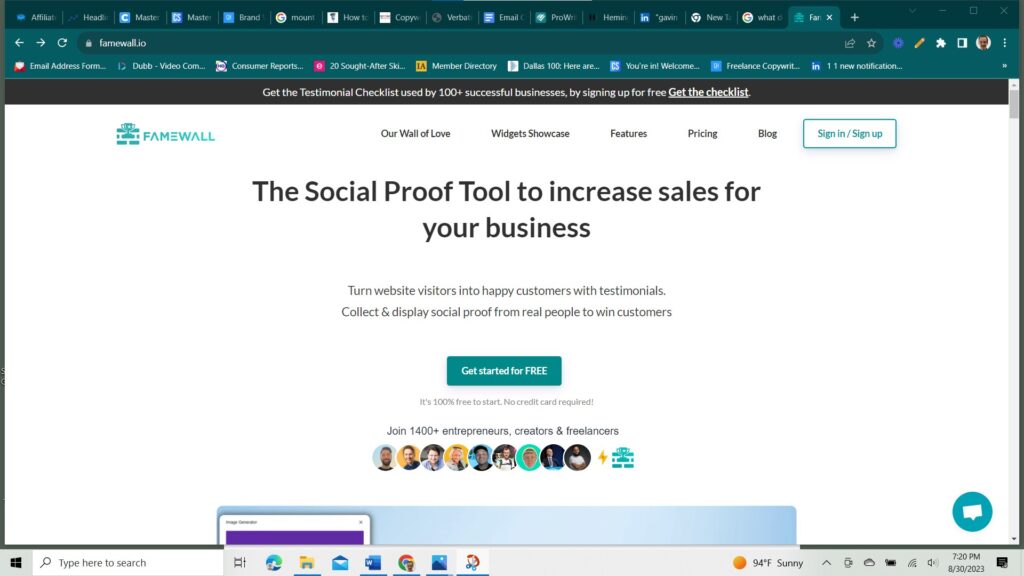
Case Study Voice of Customer
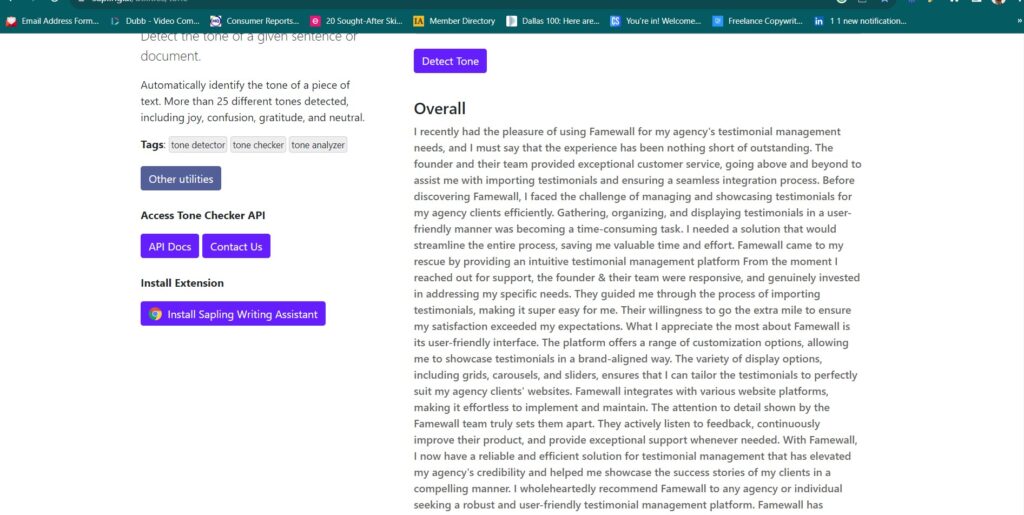
Readability level analysis
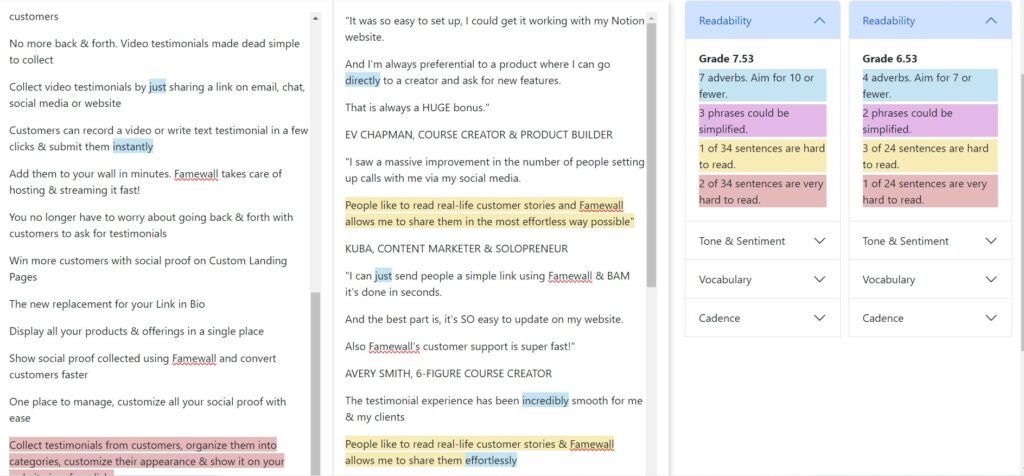
Famewall’s website is almost at an 8th grade level. But their case study VOC is on a 7th grade level.
Cadence level analysis
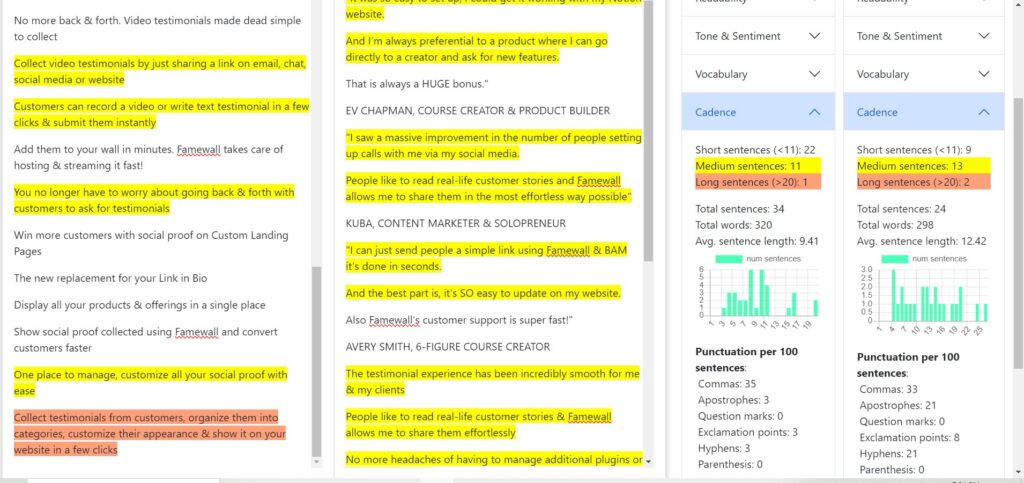
Famewall’s cadence for their website is in the mid-sized delivery range. Case studies are also in the middle range. Thus, cadence is in the zero personality zone. A definite sign of an out of synch brand voice.
Vocab use analysis
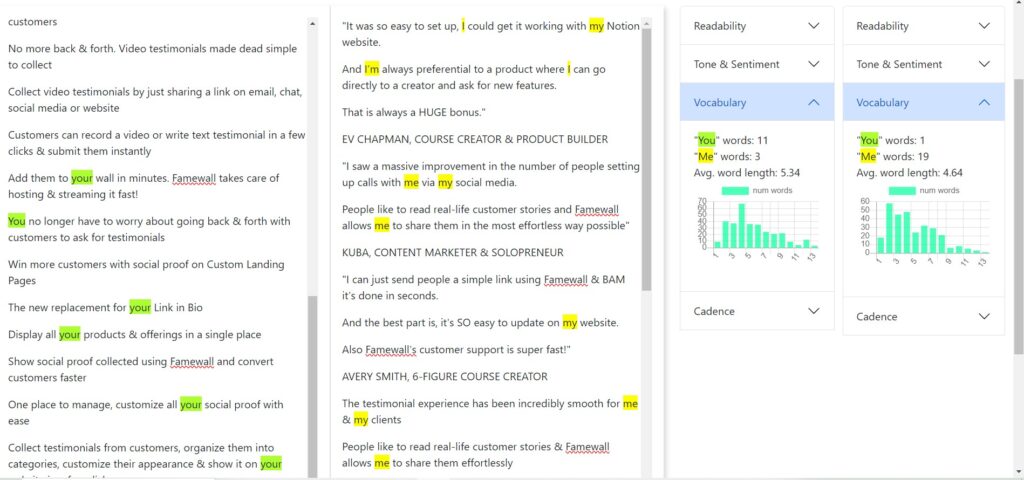
This is an interesting note. The word choice is at a 5 letter average word length on both case study (VOC) and the Famewall website. Both appear to be consistent. Yet, when the bar graphs are compared, VOC in the case study is at a different frequency.
It’s a bit more mountainous. This indicates vocab of VOC is a higher grade level.
Results
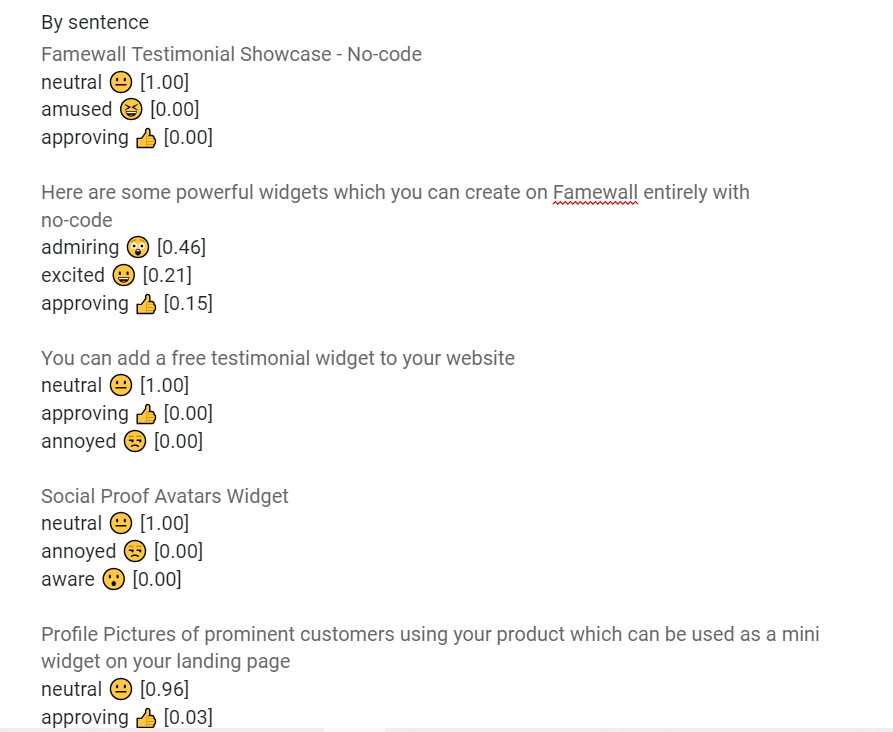
Sapling’s analysis was the most telling of all tool results. Famewall in the effort to get short on the website has stripped its copy of any personality. Also, try this tone checker for free.
Is that a positive?
Only VOC data would verify that. But looking at the Linked In account of founder, Jay Goutham, there’s a missed opportunity to capture harmonious brand voice.
Based on this sample, Famewall’s on website voice doesn’t match it’s sample of VOC. But that’s where the hypothesis needs creation and the dig into VOC takes place.
Still, Famewall’s voice is in a confusing SaaS space. It’s the authority and it’s not only making testimonials easy to understand. Famewall’s voice needs recalibration in the areas of accessibility, authority, and outlook.
What complicates the brand voice question on Famewall’s site is the lack of buyers journey in its copy.
This SaaS’s company has a homepage that is written in the product awareness high intent level. That web copy choice may be what’s taking brand voice from being a consideration.
In short, homepage = landing page = no opportunity for brand voice infusion.
Summing up.
- Writing on-brand is definable.
- Writing on-brand is measurable.
- On-brand writing matching is quicker with electronic tools
- You can deep dive into on-brand writing and Blackman has courses scaled to meet your needs.
- The best brand voice is adaptable, same personality regardless the message or setting.
One last note.
Brand voice is research based. As Blackman points out, it’s at the heart of your Voice of Customer data.
Sometimes you can change the imagery or the colors. Sometimes you soften the language, other times you ramp it up, as long as you’re writing with the goal of the customer in mind, and you have the research that supports the granular tone you’ve identified. And I’m not talking about happy or friendly. I’m talking 16 layers deep on a WordHippo search. Then you should be on the right track.
-Justin Blackman, Pretty Fly Copywriting
So, let’s go back to our review. Is Master of Brand Voice worth your $200 price tag? Absolutely.
But, the concept of writing on-brand isn’t something that you can master in 1 hour and 18 minutes. It’s something that needs to be practiced over and over in different scenarios to reach the level of mastery. Yet, this course is a step in that right direction.
If you liked this post, Woop. Woop. Do tell a friend. Share below in the comments what helped you out most.
Want to take Master of Brand Voice and try out your own 7-day money back guarantee? Click, here. I’m a Copyhackers’ affiliate, but I don’t support anything I haven’t tried out and without question found value in.
Want more of this brand of posts delivered monthly to your inbox? Sign up on my annoying, red online pop-up for your free YouTube Channel Setup Guide and join the Top-Shelf You family.
Until next time, be your top-shelf you.
